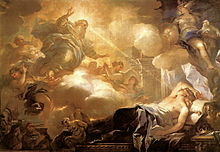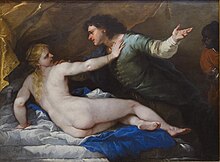Luca Giordano
His speed, in design as well as handiwork, and his versatility, which enabled him to imitate other painters deceptively, earned for him two other epithets, "The Thunderbolt" (Fulmine) and "The Proteus" of painting.
[4] Following a period studying in Rome, Parma and Venice, Giordano developed an elaborate Baroque style fusing Venetian and Roman influences.
His mature work combines the ornamental pomp of Paul Veronese with the lively complex schemes, the "grand manner", of Pietro da Cortona.
In the large block occupied by the former Medici palace, he painted the ceiling of the Biblioteca Riccardiana (Allegory of Divine Wisdom) and the long gallery of the Palazzo Medici-Riccardi.
They include the prototypic hagiographic celebration of the Medici family in the center, surrounded by a series of interlocking narratives: allegorical figures (the Cardinal Virtues, the Elements of Nature) and mythological episodes (Neptune and Amphitrita, The Rape of Proserpine, The Triumphal procession of Bacchus, The Death of Adonis, Ceres and Triptolemus).
[7] Executed in a lighter, less rhetorical style, these late works, prefiguring Rococo, proved influential throughout the eighteenth century, and were admired by Fragonard.
Other notable examples are the Judgment of Paris formerly in the Gemäldegalerie, Berlin, but destroyed in World War II, and Christ with the Doctors in the Temple, in the Palazzo Corsini, Rome.
[14] As a young man, Giordano engraved works with considerable skill, including some of his own paintings, such as the Slaughter of the Priests of Baal.
Michael Levey remarks of him "Giordano was the ideal rococo painter, speedy, prolific, dazzling in colour, assured in draughtsmanship, ever-talented and never touching the fringe of genius.






